Samsung HW-Q70R Dolby Atmos Sound Bar
Overview -Overview -- The Samsung Q70R features a 43-inch sound bar unit with Acoustic Beam technology, a wireless 8-inch subwoofer, and support for 3.1.2 Dolby Atmos and DTS:X playback. Likewise, the unit also offers 4K HDR10+/Dolby Vision passthrough, Bluetooth and Wi-Fi connectivity for audio streaming, and voice control through Alexa devices. With that said, Acoustic Beam overhead sound effects aren’t as convincing as some other systems. And the price is a bit high compared to a few rival options that include rear satellites or larger subwoofers. Still, overall audio performance is very enveloping, and the inclusion of DTS:X gives this model a slight edge over some of the competition. Recommended.
Intro
Serving as Samsung's entry-level Dolby Atmos and DTS:X compatible sound bar system for 2019, the new Q70R is designed to provide an immersive audio upgrade over integrated TV speakers while still providing a space-saving alternative to a full-fledged surround sound system.
Utilizing the company's proprietary Acoustic Beam technology, the device boasts engaging 3.1.2 playback with two overhead channels. With that said, this process doesn't seem to be quite as convincing as the dedicated upfiring and side-firing drivers used in Samsung's more expensive Q80R or Q90R systems.
And though separate rear satelelites are not included with this model, customers can purchase Samsung's SWA-8500S Wireless Rear Speakers Kit to complete a more expansive 5.1.2 configuration. But even without that add-on, the Q70R presents an enticing 3.1.2 solution on its own with very solid audio performance, features, and connectivity options.
Specs & Design
The Samsung HW-Q70R 3.1.2 system consists of a 43-inch sound bar unit with a dedicated left channel, center channel, right channel, two upfiring channels via Acoustic Beam technology, and a separate wireless 8-inch subwoofer. An HDMI cable, power cords, holder feet, wall mount brackets with wall mount screws, and a wall-mount guide are also included. In addition, a click button remote control with a design nearly identical to Samsung's mid and entry-level TVs, like the Q70 QLED, is included as well, offering straightforward functionality.
Aesthetically, the sound bar looks quite nice with a sleek, rectangular form factor marked by silver accents on the front border trim and over the sides, along with a sturdy integrated metal grill mesh concealing the front and top drivers.
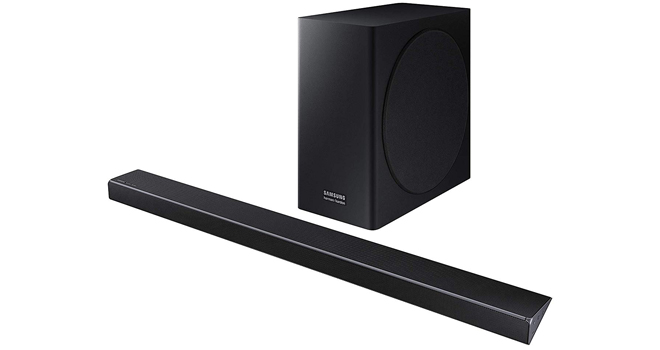
An LED text screen is also housed on the front right side which can display helpful info like audio signal type, selected modes, volume, and other settings. Though only three to four characters can appear on the screen at once, the text scrolls to display the full information, offering a welcomed upgrade over the standard blinking lights used to indicate settings and signals on some other sound bars.
In addition, buttons for power, source, and volume are included on the right-side panel. Meanwhile, the subwoofer features a relatively slim yet tall design, resembling a desktop computer tower, with a cloth grill covering the woofer on the right side.
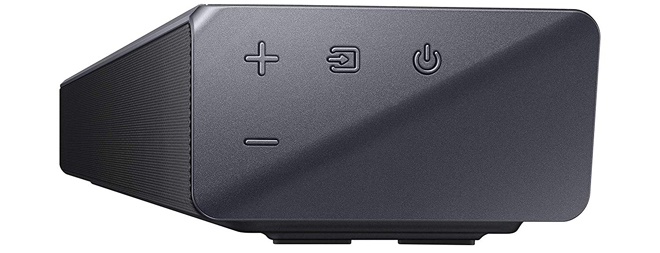
The sound bar unit measures 43.3" x 2.32" x 3.93" and weighs 7.93 lbs, while the subwoofer measures 8.07" x 15.86" x 15.86" and weighs 21.60 lbs. Together, the bar's low height and sub's relatively compact width provide flexible placement options when paired with most displays and rooms.
Under the hood, the sound bar uses Samsung's proprietary Acoustic Beam technology. This tech utilizes upfiring channels with an array of 28 holes positioned on the top left and right to enhance the unit's surround sound effect and bounce audio off of a user's ceiling for Dolby Atmos and DTS:X tracks.
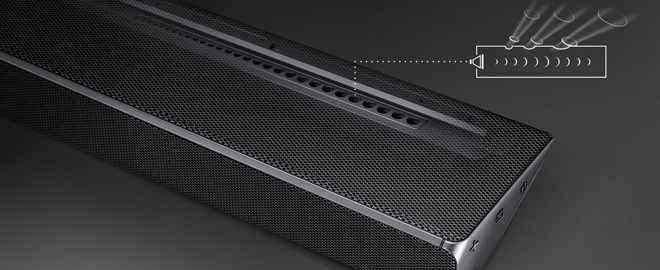
Connections featured on the back of the sound bar include an HDMI ARC out, HDMI in, and Digital Optical port on the left side; along with a power connection, USB service port, and a Wi-Fi connect button on the right side. In addition to Wi-Fi, the system also supports wireless Bluetooth connectivity. With that said, the device does not include a wired Ethernet connection option.
When it comes to audio playback, the sound bar is compatible with Dolby Atmos, Dolby 5.1ch/Dolby DD+, DTS:X, and DTS 5.1, along with support for AAC, MP3, WAV, WM, FLAC, ALAC, and AIFF files.
Setup
After unpacking the device and plugging in the sound bar and subwoofer, setup is pretty straightforward. The sub and sound bar unit will automatically pair when turned on. From there, wired playback is as simple as connecting an HDMI or Optical cable to a supported component and switching the sound bar's source accordingly.
For review purposes, I primarily used the sound bar with a Samsung Q70 QLED TV and an LG C9 OLED TV connected via the HDMI ARC port. Likewise, I also tested an LG UP970 4K Blu-ray player and a Sony UBP-X800M2 4K Ultra HD Blu-ray player connected to the HDMI in port.

In all cases, the displays and Blu-ray players were able to correctly pass audio to the sound bar, including Dolby Atmos and DTS:X tracks with no major issues. Likewise, 4K HDR and Dolby Vision video were also correctly passed through.
In addition, a Fire TV 4K connected to the TV was also able to pass Atmos audio correctly to the sound bar via ARC, though I did run into some intermittent audio sync issues with standard stereo tracks on apps like CNN Go and YouTube via that device. I'm not sure why this was case, but I've encountered similar audio sync issues with those apps from the Fire TV Stick 4K on other brand sound bars and AV receivers as well.
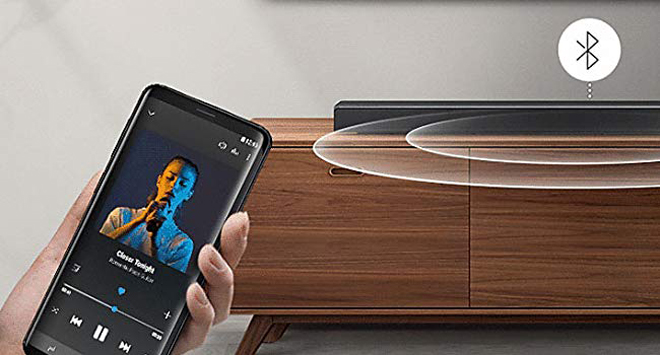
Outside of HDMI devices, users can also configure the sound bar for Wi-Fi connectivity via the SmartThings app for iOS or Android. Customers simply need to open the app and click add devices. The sound bar should then be automatically discovered allowing users to follow a few simple steps to get it connected. With that said, the app itself only offers integrated access to a very limited assortment of settings.
For control of more extensive modes and settings, customers simply need to turn to the included remote and LED display on the sound bar itself. Key options include Bass, Treble, and individual volume levels for Center, Surround, and Height channels. Oddly, however, the individual volume settings never seemed to actually do anything during testing.
Beyond standard audio adjustments, the sound bar also allows customers to choose between one of four playback modes when detecting regular stereo or surround sound, including Standard, Surround, Game Pro, and Adaptive Sound.
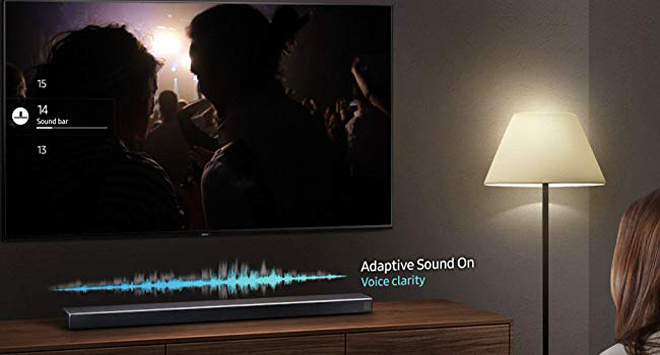
Standard Mode plays the audio signal in its native format without using the upfiring channels, resulting in 2.1 playback for stereo content and 3.1 playback for multi-channel content. Surround Mode upmixes all signals to 3.1.2 with full use of the upfiring Acoustic Beam drivers. Likewise, Game Pro Mode and Adaptive Sound Mode also upmix all signals to 3.1.2, with the former being optimized for games and the latter being designed to optimize output and dialogue levels based on the content being played.
In general, I didn't really notice much benefit when using the Game Pro or Adaptive Sound modes. Instead, I ultimately preferred to use Surround Mode for most content since it used the sound bar's Acoustic Beam technology to its fullest, creating a more expansive and deeper soundstage.
Finally, when detecting native Dolby Atmos or DTS:X tracks, the sound bar will deactivate mode selection and automatically play the content in 3.1.2, using the Acoustic Beam drivers for both height and surround effects.
Performance
To test out the Q70R's home theater performance, I sampled a variety of Dolby Atmos and DTS:X 4K Ultra HD Blu-rays and Dolby Atmos streaming titles, including movies like The Lego Movie 2, Bumblebee, Dumbo, The Matrix, Transformers: Age of Extinction, Jupiter Ascending, Wonder Woman, Blade Runner 2049, Ex Machina, and more.
In general, native Dolby Atmos and DTS:X content sounded great, with a wide and enveloping sense of immersion that extended far beyond the 43-inch width and 2-inch height of the sound bar itself.
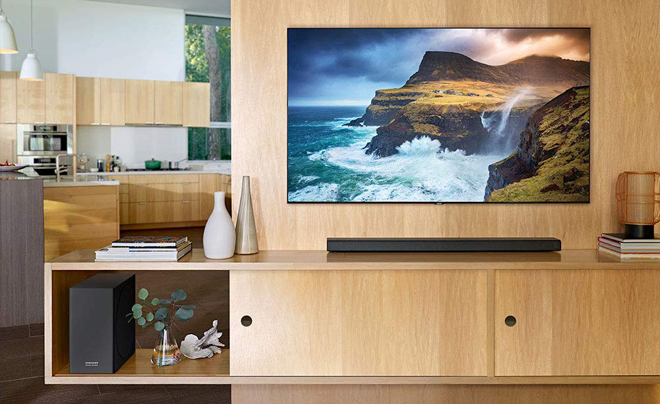
The system's sense of extended left and right presence was particularly impressive, creating a wide, wrap-around sound that seemed to stretch out in both directions and then curve slightly forward. Surround effects never quite sounded as if they were truly coming from the direct sides or rear of the listening position, but the sound bar still did a nice job of enhancing typical left/right imaging.
The inclusion of a dedicated center channel also gave dialogue proper separation and emphasis. With that said, I found that speech could have a slightly thin quality compared to some other sound bars and speaker systems in this price range. Don't get me wrong, dialogue reproduction was still generally crisp and clean, but it lacked some of the depth and resonance I've heard on other models.
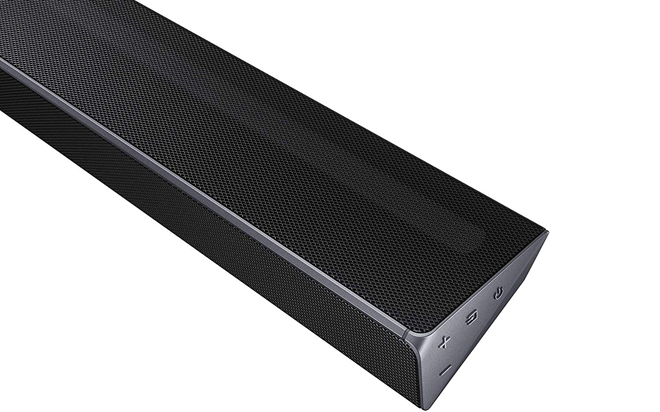
Meanwhile, Samsung's Acoustic Beam technology did a solid job of simulating a higher plane of audio, bringing added elevation to various sounds like helicopters in Bumblebee, swooshing space ships in The Lego Movie 2, and falling rain in Blade Runner 2049.
Atmos effects in The Matrix also proved to be particularly impressive, creating a dome-like audio quality during an elevator explosion and a convincing sense of overhead presence as bullets whizzed by Neo during the film's iconic rooftop shootout.
As great as key sequences like those could be, however, the unit's overhead effects tended to be much more dispersed than some other Atmos sound bars and upfiring speakers I've tested. Certain effects that have worked well on other systems -- like flapping ears in Dumbo and shaking maracas in a Dolby demo track -- all fell flat here, failing to create the sense of height that one might expect.
In all cases, Atmos and DTS:X tracks still benefited nicely from an expanded soundstage, but those looking for a more discrete sense of overhead sound might be a little disappointed. Graphics highlighting Samsung's Acoustic Beam tech show the upfiring channels projecting sound up and toward the side rather than up and forward like many other upfiring drivers, including those used in Samsung's own step-up Q80R and Q90R sound bar models. If such illustrations are accurate, it's possible that this method just isn't as convincing at creating overhead sounds.
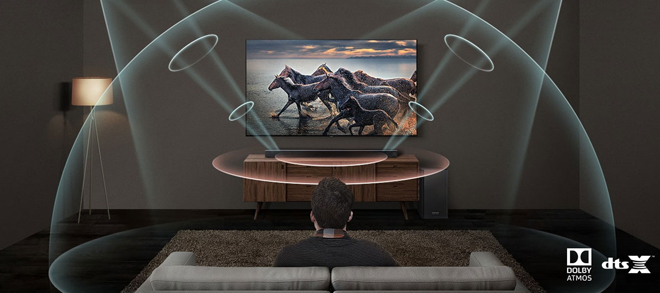
Beyond the sound bar unit itself, the wireless 8-inch subwoofer also proved to be a great performer during my testing, creating a cohesive and impactful kick. Action scenes in Bumblebee and The Matrix carried full and commanding LFE without any rattling or balance issues.
Compared to other recent Atmos sound bar systems I've reviewed, the 8-inch subwoofer here comes off as a bit more robust, balanced, and consistent than the 6-inch model included with VIZIO's 5.1.2 package. With that said, this unit fails to offer the more commanding home theater feel of VIZIO's larger 10-inch subwoofer included with its 5.1.4 system.
And outside of native Dolby Atmos and DTS:X tracks, I also sampled a variety of stereo and 5.1 titles, using both the Standard and Surround upmixing modes, including Stranger Things, Chernobyl, Barry, Shameless, X-Men: Days of Future Past, and more. Overall, I found that the Surround mode did a great job of expanding the soundscape for these titles, spreading the Mind Flayer's creepy effects further and higher around the room. As was the case with native object-based tracks, though, I rarely got a sense of true overhead audio when upmixing content.
Lastly, music sounded quite good through the Q70R as well. Tracks from artists like Radiohead, Arcade Fire, Norah Jones, Gnarls Barkley, Billie Eilish, Ariana Grande, and Pink Floyd all came through with nice range and stereo separation using the Standard mode. Bass could get just a hair boomy in some tracks and vocals could sound just a little thin, but for a system geared more toward movie playback, performance was very pleasing.
Likewise, the Surround mode actually resulted in a surprisingly engaging 3.1.2 enhancement of music. Though less accurate and prone to a slightly unnatural reverb effect, the upmixed audio created a much more spacious soundstage, providing more separation between vocals and other instruments while extending playback higher up and further to the sides.
SmartThings & Voice Control
In addition to wired playback, the Q70R also offers Wi-Fi streaming capabilities. Once connected, users can access internet radio station directly through the Samsung SmartThings mobile app. Unlike some other dedicated apps from other brands, however, SmartThings does not offer integrated access to any other services or playback support for music files stored locally on your mobile device.
With that said, other music apps like Spotify can still use the Wi-Fi connection to stream music to the bar. At least, they should be able to. For whatever reason, Spotify Connect would not recognize the sound bar initially. Thankfully, after various resets of my router, smartphone, and the sound bar itself, this problem eventually corrected itself.
Likewise, I was able to stream various MP3s and high-res FLAC files off of my smartphone to the sound bar via Wi-Fi through mobile apps like AllConnect. In general, once the connection issue was sorted out, playback was stable and consistent. I did run into isolated audio dropouts when playing a FLAC file that caused me to restart the app I was using, but outside of that, the sound bar's wireless support worked well.
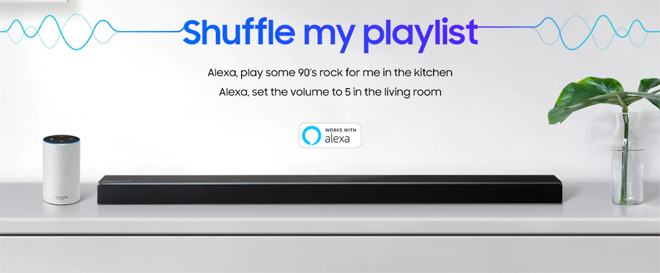
And beyond Wi-Fi streaming, the Q70R supports hands-free Alexa voice control when paired with a separate Alexa device. In practice, this feature worked great with my Echo Dot. Users simply need to configure the Samsung Wireless Skill in the Alexa mobile app and then pair their Alexa device with the sound bar. Once set up, I was able to control power, adjust the volume, switch inputs, and launch Amazon music tracks on the sound bar via voice commands.
Final Thoughts
Pros
- 3.1.2 Dolby Atmos and DTS:X support
- Great sense of space and dimension
- 4K HDR10+ and Dolby Vision pass-through
- Wi-Fi and Bluetooth connectivity
- Voice control via separate Amazon Alexa device
Cons
- Acoustic Beam overhead effects not as convincing as some other upfiring models
- Dialogue can sound a tad thin
- SmartThings app lacks integrated music services
- Doesn't include rear satellite speakers
Boasting Dolby Atmos and DTS:X compatibility, the Samsung Q70R Sound Bar is an attractive option for users who want a 3.1.2 immersive audio solution that supports both formats. The system offers enveloping audio performance, Wi-Fi connectivity, voice control support via Alexa devices, seamless integration with new Samsung TVs, an 8-inch subwoofer, and the option to add a pair of wireless surround speakers (sold separately, MSRP $130).
With that said, there are some similarly priced and, in some cases, less expensive models from companies like VIZIO that already include rear satellites or come with beefier subwoofers. Likewise, though the Acoustic Beam tech does a great job of creating a wide soundfield, overhead effects aren't as convincing as other types of upfiring sound bars and speakers I've tested.
Still, if DTS:X support is an important factor for you and you don't want/mind paying extra for rear satellites, then the Q70R is a very worthy option to consider. Recommended.












